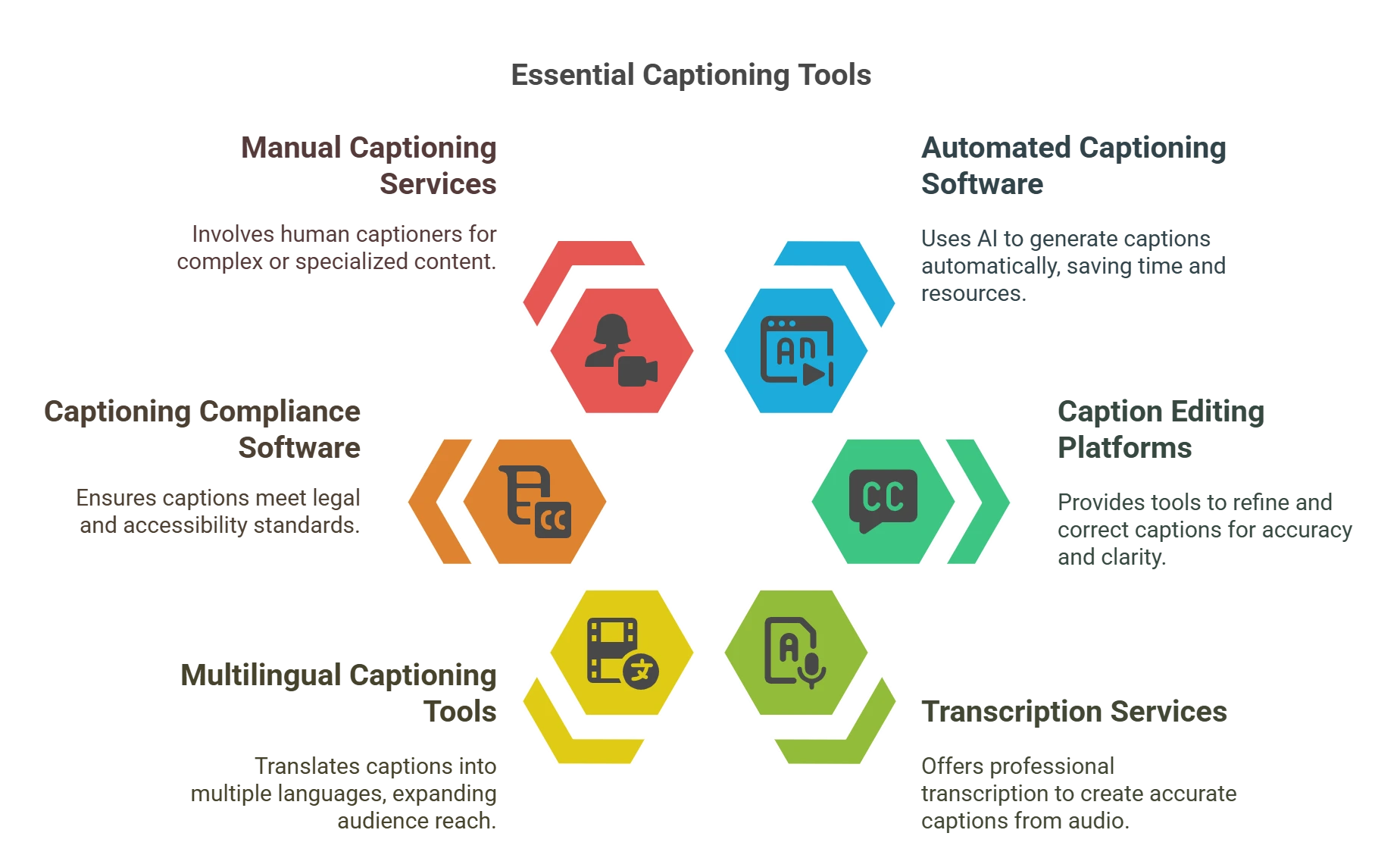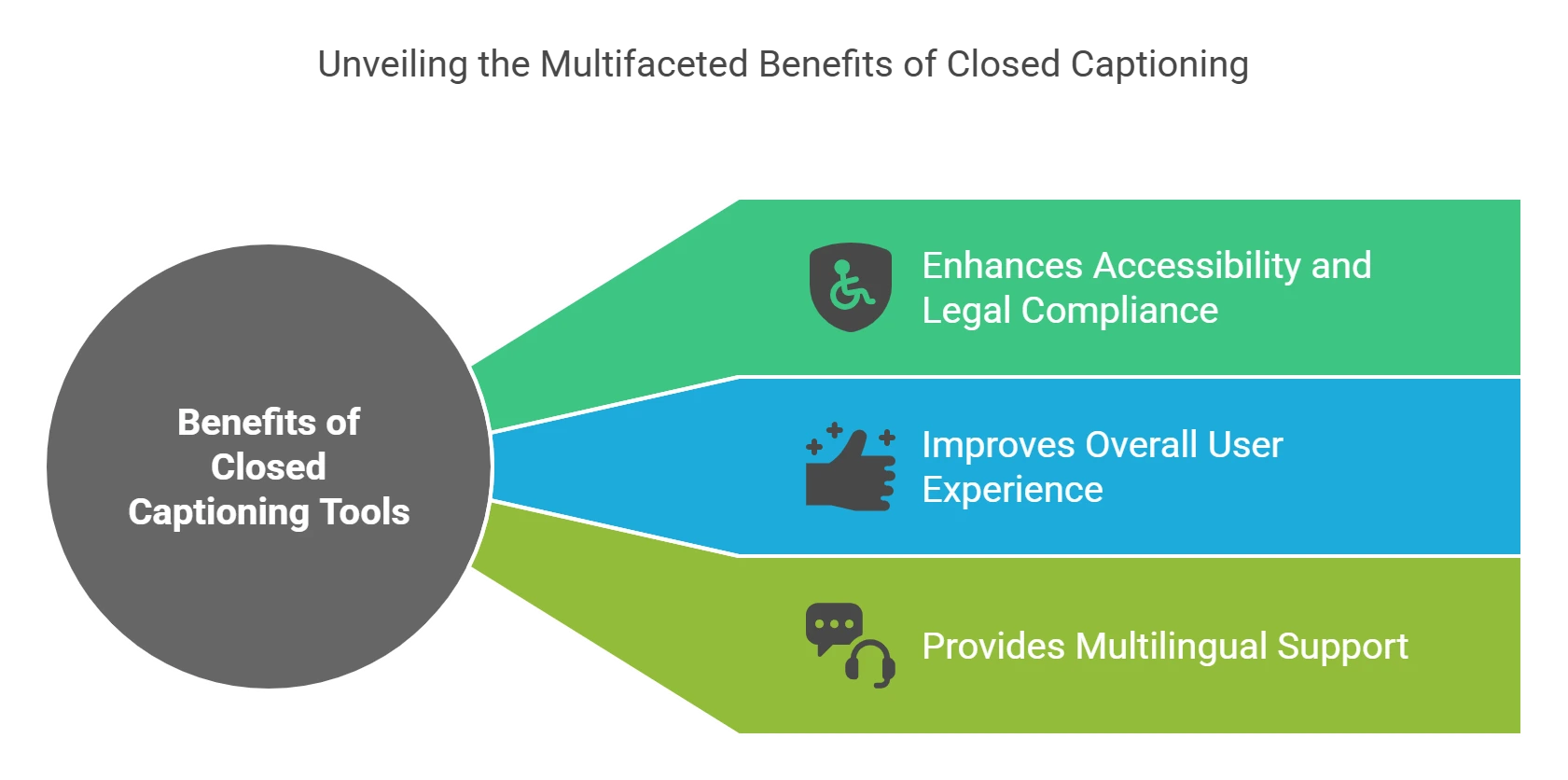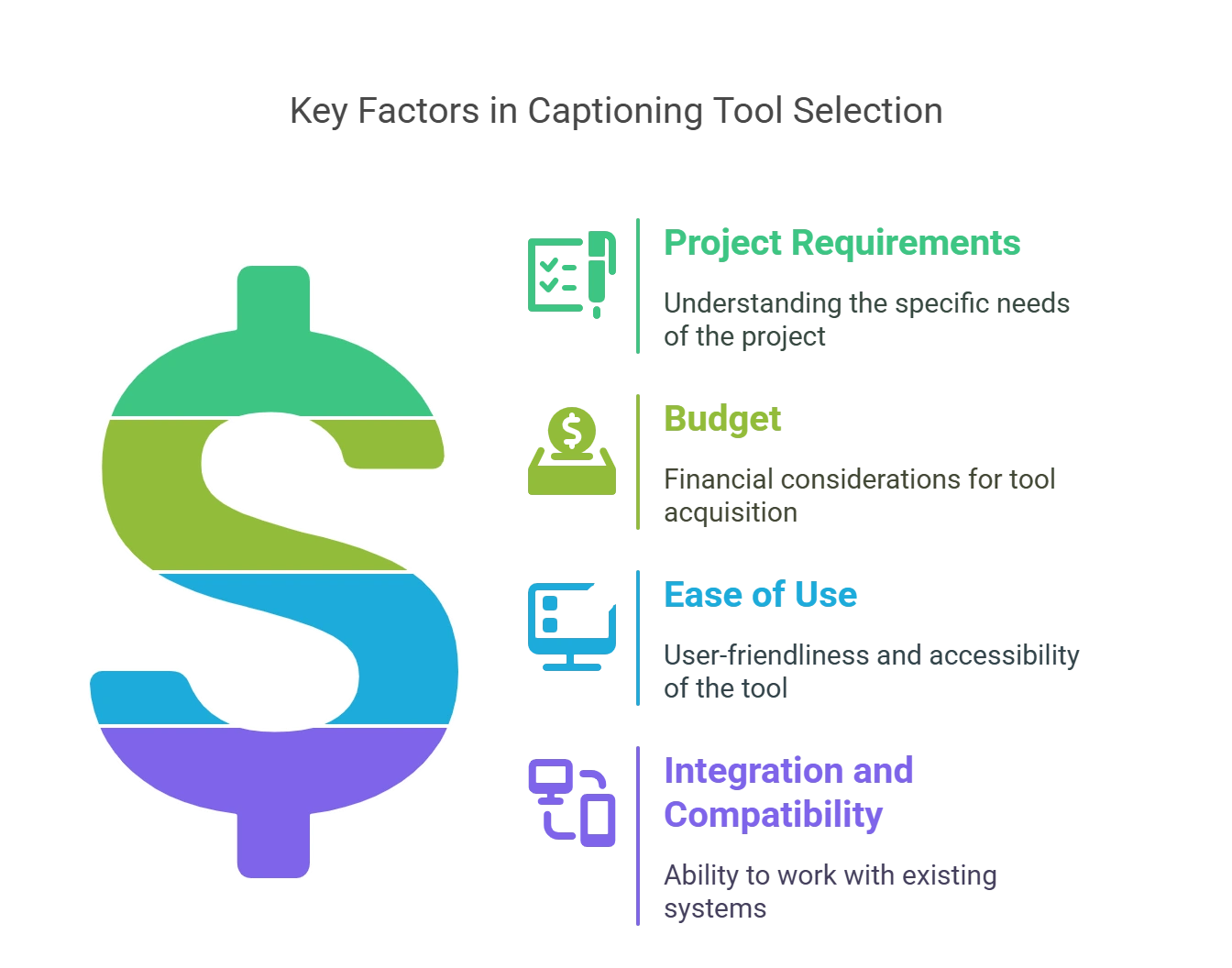
How to Choose the Best Closed Captioning Services for Your Videos
Summarize with:
Globally, video content has soared massively, with over 2,500 new videos uploaded to YouTube every minute. However, for the 430 million people with hearing disabilities, understanding this content remains a challenge—highlighting the growing importance of closed captioning services to ensure accessibility for all. With a massive proliferation of video, accessibility in video production workflows has become crucial.
But how to make video content inclusive?
It’s simple: Caption your videos.
Captions play a key role in video accessibility, allowing people with auditory impairment to understand and interact with the content.
Closed captioning tools are gaining traction due to their innate potential to enhance content accessibility and cater to a wide range of audiences. They empower production staff with legal complaint standards and help curate engaging content for multiple platforms.
This guide equips production managers with essential insights to select effective closed captioning tools for requisite outcomes.
Table of Contents:
- What are Captions?
- Decoding the World of Captions: Closed Captions Vs. Open Captions
- What are Closed Captions?
- What are Open Captions?
- Choosing Captions for Video Production: Which Factors to Consider for Better Results?
- What are Closed Captioning Tools?
- 6 Types of Closed Captioning Tools for Production Managers
- Top 3 Benefits of Closed Captioning Tools for Production Managers
- How to Select the Best Captioning Tools for Video Production?
- Wrapping Up
What are Captions?
Captions are text descriptions of dialogues, music, or sound bytes within the video. This results in inclusive content that people with hearing disabilities can access.
Now that we know what captions are, let’s quickly check out some of its benefits:
Benefits of Adding Captions to Your Video
- Inclusive content
- Boosts SEO efforts
- Improved engagement and memory retention
- Better viewing flexibility
- Legal compliance
- Comprehensible content
There are two different types of captions. Therefore, choosing the (suitable) captions for video production is the most crucial step for maximum benefits.
Decoding the World of Captions: Closed Captions Vs. Open Captions
Captions not only amplify the reach of your content but also make it accessible to all. However, most video producers often find themselves in a catch-22 situation with closed and open captions.
Read on to understand closed captions vs. open captions and examine how choosing captions for video production can impact the content.
What are Closed Captions?
Closed captions describe audio elements—from dialogue to sounds—in movies, live streams, or podcasts. The best part is viewers can choose when to turn on and off the closed captions.
This has two-fold benefits: It allows auditory-challenged individuals to understand the audio part, while others can disable the captions and enjoy the content minus distractions.
Besides, closed captions allow people who cannot hear the audio in a noisy place to understand the content.
For example, YouTube and Vimeo let the viewers toggle off/on the closed captions.
Let’s find out where they are used:
- Online video platforms like YouTube, Netflix, or Amazon Prime use automated services to interpret the audio and convert it into closed captions.
- TV broadcasters include closed captions so that viewers can turn them on or off, ensuring accessibility even in noisy public spaces.
Pros and Cons
Here’s a 360-degree perspective on closed captions:
| Pros | Cons |
| Closed captions are customizable so that viewers can enable or disable the captions. | The text overlay can be a distraction for many viewers. This might significantly alter the user experience. |
| With closed captions, viewers can see the captions in their preferred language. This enhances inclusivity, making the content comprehensible for diverse audiences. | Since these captions aren’t embedded, they may have synchronization issues. It becomes difficult for people with auditory impairments to follow what is being said. |
| It’s easy to maintain accuracy in closed captions. You can identify and promptly correct the errors, ensuring accurate and updated information. | Not all video players and devices like Instagram support closed captions. |
What are Open Captions?
Open captions are text permanently burned in a video that the audience cannot disable. Unlike their counterparts, these captions cannot be toggled on or off, as they are embedded into the video.
Open captions are always visible on the screen and work best for Instagram videos as they start playing without the audio. They make the video content more attention-grabbing, therefore increasing its engagement.
For streamlined accessibility in video production workflows, it’s essential to know where to use open captions:
- For platforms that don’t support closed captions, like Instagram or TikTok, burned-in text ensures the message is conveyed.
- These captions are great for videos displayed in noisy public areas such as waiting rooms, public transport, or shopping malls.
- Burned-in text provides a visual reference point to multilingual/non-native viewers and helps them follow the video content.
- Open captions for educational videos help students with hearing disabilities to understand the learning material.
Pros and Cons
Let’s compare the advantages and pitfalls of pros and cons:
| Pros | Cons |
| It has a universal application – it can be added to video platforms that don’t support closed captions. | There’s little to no scope for customization. Since the texts are embedded, the viewers cannot disable them as per their preference. |
| It enhances overall comprehension, especially when the audio quality is terrible. The visual representation reinforces the spoken words, making the message available to all. | The readability of an open caption depends on a video’s quality. The captions may be difficult to read if a video is blurry or pixelated. |
| Open captions cannot be optimized for mobile viewing. |
Choosing Captions for Video Production: Which Factors to Consider for Better Results?
1. Analyze the Viewing Habits
For seamless accessibility in video production workflows, analyzing the viewing patterns and habits is critical.
Before determining which caption type would work best, examine how and where your audience watches the content.
Let’s understand this with an example. If you are into e-commerce and want to reach the target audience on Instagram, open captions are your best bet. This caption type is more effective for social media platforms as viewers can watch and understand the video without audio.
Additionally, your choice of caption can affect the user experience. For instance, closed captions allow viewers to choose when to enable or disable the captions.
2. Determine Device Compatibility
Before choosing captions for video production, make sure to determine device compatibility. It’s vital to ensure that the viewing platforms where you intend to disturb support the content and the caption type.
For example, Netflix supports closed captions, while open captions are an excellent choice for platforms like X due to their autoplay features.
3. Take Your Technical Resources into Account
One key element of the closed caption vs. open caption debate is considering your technical expertise. Though video streaming platforms have automated captioning features, you require skills like encoding format and synchronization techniques. This means that you may be required to invest significantly in technical resources.
What are Closed Captioning Tools?
In publishing, closed captioning tools are software or applications that let publishers add text-based captions to multimedia content, such as webinars, online courses, and videos.
These tools convert spoken dialogue into text using speech recognition technology. The text is then shown on the screen with the audio or video.
With closed captioning tools, which visually show the spoken words, content can be accessed by those who are hard of hearing. To help publishers with the captioning process, these tools may also include features like
- Automated captioning
- Multilingual support
- Customization options
All things considered, closed captioning tools are essential to publishers’ ability to produce inclusive content that appeals to a larger audience.
6 Types of Closed Captioning Tools for Production Managers
Production managers in the publishing industry can create engaging and accessible content using various closed captioning tools.

The following are a few typical categories of closed captioning tools used in publishing:
1. Automated Captioning Software
Automated captioning software employs advanced speech recognition technology to generate captions for videos and multimedia content.
These tools transcribe spoken dialogue into text, rendering the captioning process efficient for publishers.
2. Caption Editing Platforms
Production managers can check captions for correctness, timing, and style with the help of caption editing tools.
To provide viewers with a flawless viewing experience, these tools frequently come equipped with features like
- Spell check
- Formatting
- Modification of typeset
- Appropriate placement of captions
3. Transcription Services
Transcription services are the process of turning spoken words into written text from audio or video. The text is broken up into timed sections corresponding to the spoken word delivery in the content to form a caption.
This ensures that the captions will appear on screen as needed, allowing viewers to follow along with the discourse.
4. Multilingual Captioning Tools
Multilingual captioning systems help publishers select accessible content for a worldwide audience by translating captions into several languages.
These programs can translate text automatically or provide a platform for human translators to provide captions in several languages.
5. Captioning Compliance Software
Publishers can use captioning compliance software to ensure that their content conforms with accessibility standards and legal obligations such as the Americans with Disabilities Act (ADA).
These tools help production managers monitor accessibility compliance across their publishing platforms. They include features like caption validation, compliance checks, and reporting.
6. Manual Captioning Services
Manual captioning services are provided by human captioners who transcribe captions for videos and other multimedia content.
Manual captioning can be more expensive and time-consuming than automatic solutions. However, it is a good choice if you need precise captions for intricate or specialized information.
Top 3 Benefits of Closed Captioning Tools for Production Managers
Production guides to captioning tools often have features like automatic speech recognition (ASR), subtitle edits, and QA.

Here are the top benefits of such captioning tools for production managers and consumers:
1. Enhances Accessibility and Legal Compliance
Closed captioning technologies are a useful tool for helping companies comply with accessibility laws such as the Americans with Disabilities Act (ADA) and the Web Content Accessibility Guidelines (WCAG).
These resources provide accurate captions for multimedia content, confirming that information accessibility is not impeded for those with hearing loss.
Breaking these restrictions could have legal repercussions, including lawsuits and fines.
2. Improvers Overall User Experience
Closed captioning services improve user experience by embedding accessibility features with precision.
When text-based captions are used with audiovisual content, publishers can more easily accommodate non-native speakers, viewers in noisy situations, and individuals with hearing impairments. This inclusive strategy boosts viewer engagement and retention by ensuring all users fully comprehend the material.
3. Provides Multilingual Support
By using closed captioning software, publishers can target various audiences and translate subtitles into many languages. Closed captioning services also make the information more globally relevant and accessible.
Consider cultural references, grammatical usage, and localized vocabulary when translating your material into multiple languages. Constructing distinct closed captioning service tracks for different language regions can be necessary.
How to Select the Best Captioning Tools for Video Production?

Selecting video captioning software involves considering various factors, such as:
1. Project Requirements
Consider your project’s needs before choosing a captioning tool. Take into account elements like
- Number of videos that need to be captioned
- Languages in which the captions must be written
- Requisite formatting or customization needs
Select a tool that can effectively manage the scope of work and is in line with the requirements of your project.
2. Budget
When choosing a captioning tool, consider your financial constraints. While some tools charge by the minute for captioned videos, others have subscription-based pricing structures.
You must analyze each tool’s cost-effectiveness in light of the demands of your project and your financial constraints.
3. Ease of Use
Select a captioning tool that is simple to use and navigate. To ease the process of captioning, look for automated options and user-friendly interfaces.
An easy-to-use tool can increase productivity and save time when producing videos.
4. Integration and Compatibility
To guarantee a smooth integration, look for tools compatible with well-known video editing platforms and software.
Compatibility with various file formats and video-hosting services can also enhance workflow efficiency and streamline captioning.
Wrapping Up
Captions are great for ensuring accessibility in video production workflows. When deciding which caption type to use, it’s an excellent idea to analyze closed and open captions comprehensively.
While both options offer incredible benefits, understanding their strengths and limitations helps you make informed decisions.
To streamline captioning workflows with tools, look for features like automated caption generation and integration with your existing production tools.
Closed captioning tools help production managers demonstrate that they genuinely try to accommodate people with disabilities. This proactive strategy helps with legal compliance and enhances the organization’s reputation as an inclusive company.
To make your digital content more legally compliant and accessible, Hurix Digital offers end-to-end accessibility services. We offer efficient closed captioning services for various multimedia types using cutting-edge automation technologies.
For more information, contact us now!
Summarize with:

Vice President – Content Transformation at HurixDigital, based in Chennai. With nearly 20 years in digital content, he leads large-scale transformation and accessibility initiatives. A frequent presenter (e.g., London Book Fair 2025), Gokulnath drives AI-powered publishing solutions and inclusive content strategies for global clients
 Upcoming Masterclass | Build an Army of Brand Evangelists using Training & Development | November 20th, 8:30 AM PDT | 11:30 AM EDT | 10:00 PM IST
Upcoming Masterclass | Build an Army of Brand Evangelists using Training & Development | November 20th, 8:30 AM PDT | 11:30 AM EDT | 10:00 PM IST

